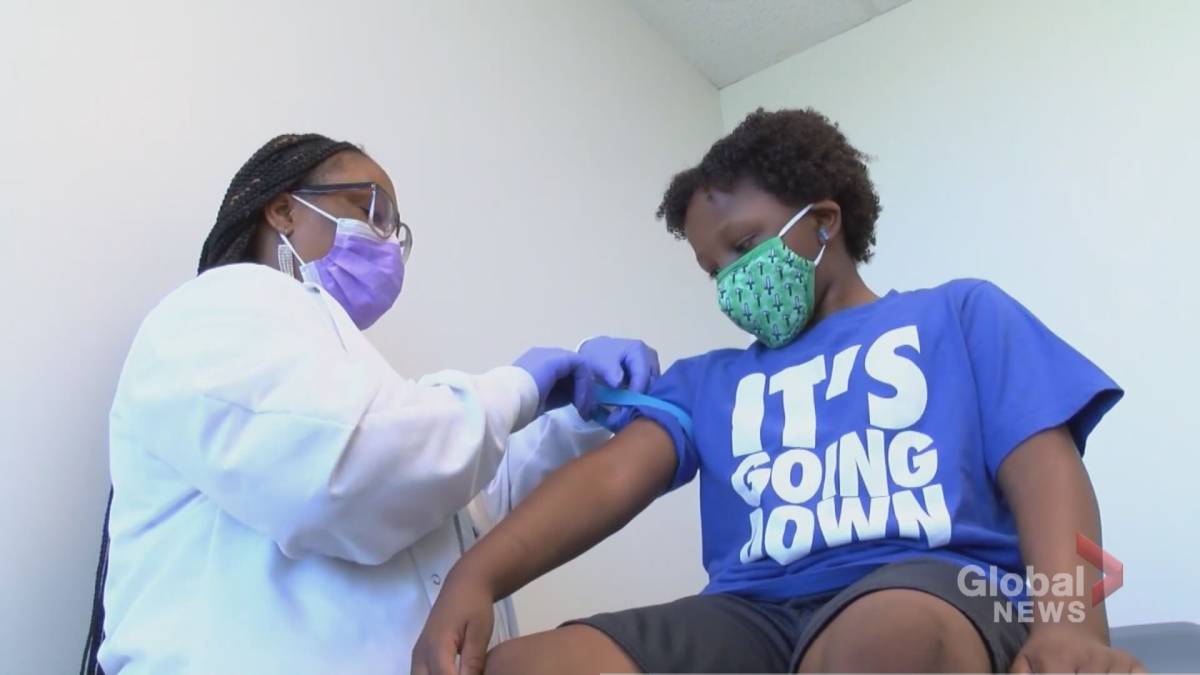TORONTO – COVID-19 cases are on the rise again in Ontario in a trend that experts attribute to chilling temperatures, lifting capacity limits and less stringent precautions among the public.
“We are definitely out of the honeymoon phase and back into wave four,” Dr. Peter Juni, scientific director of the Ontario COVID-19 Scientific Advisory Board, said Monday.
The seven-day average of infections has risen to 476 from 362 a week ago, with daily counts ranging from the mid-400 to the mid-600 since late last week. On Monday, the province reported 480 new cases and two deaths related to the virus.
Read more:
East York Community See Lowest COVID-19 Vaccination Rate in Toronto – City Data
Juni said the trend marks the end of a plateau in infections that followed a previous hit in July, the beginning of the fourth wave, when the province’s economic reopening accelerated and people began to interact in greater numbers. .
Millions more Ontario residents were vaccinated against the virus during the summer, Juni said, and people’s behavior remained at a constant level, prompting a decline in infections in the fall.
But things started to change in mid-October when the province began to lift capacity limits at sports venues and later at restaurants, Juni said. Then the weather began to cool down, leading to meetings indoors. People may also have started to take less precautions in light of those changes and the high vaccination coverage in the province, he said.
More than 85 percent of residents 12 and older have received two doses of the COVID-19 vaccine, although there are some variations by age and region.
New cases have been highest among young people, who have slightly lower overall vaccination rates. And the recent spike has hit some regions harder than others.
Public health officials for the Sudbury, Ontario area said Monday they would reintroduce capacity limits, require masking at organized public events and require proof of vaccination for youth sports amid a “record number” of virus outbreaks and an “alarming” increase that is not linked to any particular environment.
Read more:
Ontario Reports Fewer Than 500 New COVID-19 Cases, 2 More Deaths
The region’s top doctor said the rise in positive tests is in line with the province’s lifting of some public health rules in mid-October, saying local measures are necessary to correct course.
“Obviously, no one wants to hear this news, but we have to turn back time and protect people and the healthcare system,” Dr. Penny Sutcliffe said in a statement. “We are implementing these protections as a ‘circuit breaker,’ in an effort to disrupt chains of transmission within the community and protect local businesses and workers _ we hope _ avoiding any need for more drastic measures.”
The Waterloo region said Monday that the daily case count had doubled in the region, with unvaccinated people the worst hit and groups at private social events with limited public health measures a significant contributing factor.
Dr. Hsiu-Li Wang, the region’s top physician, said the change is not unexpected as people socialize more and spend more time indoors.
“However, it is a reminder that the Delta variant will spread rapidly when given the opportunity, and that getting vaccinated and continuing to take public health precautions in our interactions with others is of the utmost importance,” he said in a statement.
University of Toronto public health professor Barry Pakes pointed to factors similar to June’s: cooler weather and lax public health measures that may have encouraged people to lower their guard.
Pakes said the trend is worrisome but not too worrisome yet, he thought it could mean that cases are even higher next month when people start flocking for the holidays.
Read more:
The United States border is reopening to Canada. What you need to know before traveling
“Anyone considering getting together with family or friends over winter break, who is among the 10 percent who are not vaccinated, this is the time to get vaccinated,” he said. “I think we are at a very important juncture with respect to that.”
He said pending approval of vaccines for young children, which is expected in the coming weeks, and eventual booster doses for more people may also help keep the situation manageable into the new year.
Vaccination can also make the difference between “a persistent upward trend” in cases or a sustained “gradual slope,” Pakes said.
Juni said that reintroducing capacity limits can help with the situation, adding that people have the power to help stabilize course through behavior changes such as avoiding crowds, wearing masks indoors and working from home if possible.
“There is absolutely no need to panic,” he said. “Our destiny is in our own hands.”
See link »
© 2021 The Canadian Press
Reference-globalnews.ca
